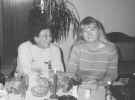 Mother and I had a wonderful visit to
Germany. Barth is an incredibly pretty and clean old town. It was once a
walled medieval city. The only part of the old wall left is one of the
gates. The POW's had to march through this gate to get from the train station
to the camp when they arrived at Barth and upon our arrival at Barth we had to
drive right through this gate. Mother and I had a wonderful visit to
Germany. Barth is an incredibly pretty and clean old town. It was once a
walled medieval city. The only part of the old wall left is one of the
gates. The POW's had to march through this gate to get from the train station
to the camp when they arrived at Barth and upon our arrival at Barth we had to
drive right through this gate.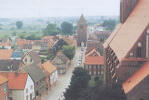 I got the strangest feeling, and I started
trying to imagine what Daddy must have felt while marching through this gate
to the POW camp. Then I realized it was too much for me to even try and
imagine the range of emotions he must have been experiencing. To be 22 years
old and alone as a prisoner in a foreign country, starving, freezing, scared,
and worrying about what his family knew or didn't know about his current
situation, it must have been just over-whelming for him and so many others. I got the strangest feeling, and I started
trying to imagine what Daddy must have felt while marching through this gate
to the POW camp. Then I realized it was too much for me to even try and
imagine the range of emotions he must have been experiencing. To be 22 years
old and alone as a prisoner in a foreign country, starving, freezing, scared,
and worrying about what his family knew or didn't know about his current
situation, it must have been just over-whelming for him and so many others.
The " 55th Anniversary of the
Celebration of the Liberation of Stalag Luft I POW camp and the Concentration
Camp Barth" was organized by the "Documentation and Dialogue Center
of Barth Association". This organization is composed of some 25 members
and was founded in November 1998. Their aim is to initiate and support
research and educational work in the field of local history of National
Socialism, the Second World War and injustice between 1945 and 1989. The
Association is trying to establish contact with survivors of the Concentration
Camp Barth, Stalag Luft I and the Forced Labor Camps.
They kept us busy the entire time, from
early in the morning to late at night....on the go. There were only 5 former
POW's from Stalag Luft 1 that made it back. This was no doubt due to the age
of many of the survivors and the difficulties of traveling such a long
distance. Many who were not able to make it in person sent their stories to
Helga Radau, the town archivist, to be incorporated into the record of the
conference. In addition there were 9 sons/daughters of former POW's (like me)
there. There was 1 Russian woman, a former nurse in the Russian Army and
1 Russian man attending. The Russian POWs were kept in a separate camp from
the British and American POWs and were treated much worse because they were
not signers of the Geneva convention. The Concentration Camp Survivors
consisted of 8 women and 4 men. All were very old and had traveled from great
distances to attend. Of course their stories were the most heartbreaking and
spoke of undue cruelty. One man told of how he was incarcerated simply
because, as a young boy, he stopped to listen to a speech that was being given
on a city street by some coal miners who were protesting their working
conditions. For this reason, (he was listening to something that he should not
hear) he was arrested and sent to the concentration camp. He remained there
for several years, beaten daily. He said that he would just have to stand
there while the guards beat him every day.
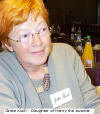 I learned so much and met some wonderful
people. I met and became friends with the daughter of a former German
guard in the North II section of the camp. After meeting her and hearing
her heart wrenching story, I realized that we were ultimately just 2 daughters
that loved and missed their fathers, not the daughters of former
enemies. Her father was called Henry the Butcher
by the prisoners. He
was called that because he had lived on Long Island in the United States where
he owned a butcher shop prior to the war. His mother became sick shortly
before the war broke out and they had to return to Germany. Grete said her
mother begged her father not to return, but he felt he had to return and take
care of his mother. Then of course the war broke out and he was drafted.
He was sent to work as a guard in the intelligence section at Stalag Luft I in
the North II compound. Grete brought some photos that her father had taken at
the camp and sent home during the war. They were fascinating. The pictures of
the guards and the tunnels that the prisoners had dug. The guards are
laughing and pointing at the tunnels. You can see that they were so pleased
with themselves to find the tunnels. Grete's father never returned from the
war. Others in her hometown had family that did not return, but they knew what
had happened to them. Grete and her mother did not know what had happened to
her father. He just did not return. They were living in West Germany and Barth
was in East Germany. As soon as the wall came down and the country was
reunited in 1989, Grete went to Barth questioning everyone to see if she could
find out what had happened to her father. No one knew, or so they
said. When the ex-POW's started returning to Barth, she would go to see
them and ask questions. Finally, one of them asked her if she wanted to
know, even if it was bad. She said that she did. He then told her that
her father had been killed by an American ex-POW shortly after
liberation. The night of the banquet at the Town Hall, she came to me
holding a piece of paper and asked me to read it. It was an email
that Helga Radau (the town historian and the moving force behind the
conference) had received that day from an ex prisoner that stated that he knew
and respected Grete's father and would be glad to meet with her on her
upcoming trip to the USA. She was so happy and I told her how happy I was for
her also. She and her husband were leaving for the states the following
week. Anyone reading this that may have additional information
about Henry the Butcher no matter how insignificant you feel it is please
email me and I will pass it on to her. I learned so much and met some wonderful
people. I met and became friends with the daughter of a former German
guard in the North II section of the camp. After meeting her and hearing
her heart wrenching story, I realized that we were ultimately just 2 daughters
that loved and missed their fathers, not the daughters of former
enemies. Her father was called Henry the Butcher
by the prisoners. He
was called that because he had lived on Long Island in the United States where
he owned a butcher shop prior to the war. His mother became sick shortly
before the war broke out and they had to return to Germany. Grete said her
mother begged her father not to return, but he felt he had to return and take
care of his mother. Then of course the war broke out and he was drafted.
He was sent to work as a guard in the intelligence section at Stalag Luft I in
the North II compound. Grete brought some photos that her father had taken at
the camp and sent home during the war. They were fascinating. The pictures of
the guards and the tunnels that the prisoners had dug. The guards are
laughing and pointing at the tunnels. You can see that they were so pleased
with themselves to find the tunnels. Grete's father never returned from the
war. Others in her hometown had family that did not return, but they knew what
had happened to them. Grete and her mother did not know what had happened to
her father. He just did not return. They were living in West Germany and Barth
was in East Germany. As soon as the wall came down and the country was
reunited in 1989, Grete went to Barth questioning everyone to see if she could
find out what had happened to her father. No one knew, or so they
said. When the ex-POW's started returning to Barth, she would go to see
them and ask questions. Finally, one of them asked her if she wanted to
know, even if it was bad. She said that she did. He then told her that
her father had been killed by an American ex-POW shortly after
liberation. The night of the banquet at the Town Hall, she came to me
holding a piece of paper and asked me to read it. It was an email
that Helga Radau (the town historian and the moving force behind the
conference) had received that day from an ex prisoner that stated that he knew
and respected Grete's father and would be glad to meet with her on her
upcoming trip to the USA. She was so happy and I told her how happy I was for
her also. She and her husband were leaving for the states the following
week. Anyone reading this that may have additional information
about Henry the Butcher no matter how insignificant you feel it is please
email me and I will pass it on to her.
I also met Mark Shore, the son of the only
man (John Shore) to ever tunnel out of Stalag Luft 1 and make it back to
England. Mr. Shore's partner in tunneling was the famous Bertram Arthur
"Jimmy" James. Mr. James
did not escape with Mr. Shore because when the time came to make the break in
the tunnel, Mr. James was trapped in another part of the camp. Mr. James
became famous later for tunneling out of Stalag Luft III as part of "The
Great Escape". Fortunately he was not one of the 50 men who were executed after being recaptured by the Germans. He was
recaptured and sent to a concentration camp as punishment for the escape. Mr.
Shore's son offered to send me the official report his father made to the
British government concerning his escape from the prison camp. He asked if I
would like to add it to the website. Of course I said yes. I hope to receive
this and add it to the website in the near future.
The ex-POWs I met were wonderful. Leland
Smith of Kentucky had been there the longest time---2 years. He was in
the West (South) compound. Kenneth Blyth (Royal Canadian Air Force) of Naples,
FL was also
in the West compound, he arrived there in March 1945 and he has written a book
called "Cradle Crew" about his war experiences as a Halifax pilot and
his time as a POW at
Stalag Luft I. His wife Sarah and son Jeff were there also. Jeff
Blyth is a film maker and was there filming the entire conference.
Then there was George Lesko of Lee's Summit,
MO. He had been in North II since he was shot down in August of 1944.
George's son, Greg is also a film maker and was there also documenting the
conference. George piloted a plane back onto the Barth airfield while we
were there, fulfilling a wish he had made 55 years ago when he was flown out
of Barth. That wish was to fly a plane back onto the airfield one day.
George found out in 1997 that, after they bailed out, 6 of his crew were
captured by the SS and killed execution style by a shot in the back of the
head. He also learned that these SS men were caught after the war and tried as
war criminals and executed for this crime. He said he was going to send me the
text from the war crimes trial. That should be very interesting. The city in
France where they were shot down erected a monument to his crew several years
ago and this is when he first learned of the fate of his crew. Next was Bruce
Bockstanz of Grosse Point, MI. He had been shot down in July 1944 and
imprisoned in North II. He managed to evade for a while, but was
eventually caught and badly mistreated (i.e. beaten) before being sent to
Dulag Luft. He has mailed me his complete story, which has very some
wonderful detail and I will be adding it to the website soon.
Finally there was Virgil Colson of Tampa,
FL, who holds a Ph.D. in Biblical Interpretation. He has
served as a Bible Teacher and Pastor in Texas, North Carolina, California,
Hawaii, and as a missionary in Liberia, West Africa. He was shot down on November 30,
1944, just four days after our Dad was. He was in the North III compound like Dad, but
doesn't remember Dad after all these years. Virgil, the pilot of his plane,
was the only one of his crew to survive the midair explosion. He
told of experiencing survivor's guilt (which often accompanies these type
situations) and how he had turned to missionary work as a means
to try and make up for the loss of his crew. Every where he would go on his
missionary work, he would
select 10 young men that he would recruit for good works. This was to account
for the 10 men that were lost on his plane that day. They had an additional
man on board observing that day so there were 11 total on the plane rather
than the normal 10 crew members.
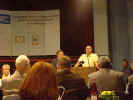 |
Bruce Bockstanz addressing
the conference in Barth. |
The first day of the conference was mostly
the eyewitnesses giving their accounts. Of course each speech had to be
translated into 3 different languages (English, German and Russian). This was
rather time consuming and often hard to follow, but interesting and moving. On
the second day we toured the local high school, which has a very modern new
section built 4 years ago and an old section that was part of the former Flak
school. The students put on a small musical program for us. Then we broke up
into discussion groups with the POWs in one group and the concentration camp
survivors in the other. I, of course, attended the POW group. Helga had
invited Grete, the daughter of the German guard who was killed by the American
POWs, to speak and tell her story.
Next Fritz Osterman, .a
German man that had worked in the administrative offices at the camp, told of
his experience with the camp and POWs. His contact with the POWs was very
limited but he had a particularly funny story which truly showed the humanity
of man and how enemies can relate on a personal basis even in war. On
January 20, 1945 at roll call it was so cold the POWs of Block 207 in the North
2 compound did not want to take their hands out of their pockets. After
being instructed to do so several times by the German guards (Oberstl. Jager and
Hauptmann Blohm), an American, Major Fred Ford Bronson, instructed his
fellow prisoners to keep their hands in their pockets. He told the German guards
that if they wanted them to keep their hands out of their pockets then they
should provide the prisoners with gloves because it was just too cold. This was
considered an act of insubordination and he was promptly arrested and a trial
was scheduled at Anklam, Germany. So Fritz Osterman, who
was a private in the German military, was given a gun and assigned to transport the prisoner to
Anklam, where the trial would be held. The trip took a long time because of
the poor condition of the rail system due to the Allied bombings. Fritz said that
Major Bronson had a nice Red Cross parcel which contained canned goods,
chocolate and cigarettes. He was impressed and the American shared his
parcel with
him. They finally reached the location of the trial and Major Bronson was
assigned a German lawyer to defend him. As the trial began, Major Bronson stood
up and said, "I am a citizen of the United States of America and I demand an
American lawyer to defend me." With this his assigned German lawyer was highly
offended and said, "Well then, I refuse to defend you." The judge then declared
that the trial would be postponed indefinitely. So Fritz and Major
Bronson began their journey back to Stalag Luft I. Along the way they were
to pass through Fritz's hometown. He stated that he really wanted to see his
family, but his English was not so good. So he found another German to explain to
Major Bronson that he wanted to stop by and see his family and asked that Major
Bronson not tell on him. Major Bronson agreed as he wanted to see what a German
household looked like. So they go to Fritz's house and his mother
opens the door. She is very happy to see her son, but soon becomes very
upset when she realizes he has an American "terror flieger" (terror flyer) with
him. She tells her son, "Are you crazy? The local head of the SS lives next door
and if he sees this, he will execute all of us." Her son tells her that the
American has chocolate and cigarettes!! This made her warmly welcome him into her
home. They had a short visit and the American shared some of his goodies. They
then continued their return trip to Stalag Luft I. He said he has never seen or
heard from Major Bronson since then and would love to get in contact with him.
He said Major Bronson was about 10 years older than him so that would make Major
Bronson around 85 today.
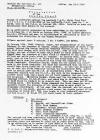 |
|
The official charge report of the incident |
Next a man spoke of how his family home was
located just across from the POW camp and as a young boy he remembered feeling
safe from the bombings because his parents told him the allies would never
bomb Barth because the POW camp was located there. He also told of how the
children of Barth were given ice skates that the Red Cross had sent for the
prisoners. The skates were initially given to the prisoners, but were taken
away when the prisoners started making tools for escape out of them. This man
said the American skates were much better than the German ones and all the
German kids wanted to get a pair of the American skates. Next he told of the
day the camp was liberated and how he and his grandfather had been out
fishing. When they returned they ran across some of the newly liberated POWs.
He was very scared, but his grandfather was not. He felt his grandfather was
very brave. They approached the POWs and the POWs wanted their fish. The POWs
offered to trade some of the contents of their Red Cross parcel with the
grandfather for the fish, which he did.
Next an older lady told a similar story
about the day of liberation and of some POWs coming to her house. Here they
found a pair of binoculars that they wanted to trade with her for some
cigarettes and chocolate. She readily agreed to do this.
Then the POWs each told a little of their
stories. Of course this was all very time consuming, because again you had to
translate everyone's speech into either German or English for all to
understand. There was very little time left for the students to ask questions,
but a couple were asked, mostly to the POWs and their families. Someone asked
the German private how he felt and was he surprised when Germany lost the war.
He said he was devastated, it was like his whole world had collapsed on that day. I got the feeling that
he was really surprised when the actual defeat happened. He was captured
shortly after the Russians liberated the camp and remained a prisoner of war until 1948.
We then had visits to place flowers on both
the Concentration Camp Memorial and the Stalag Luft I Memorial. The Stalag
Luft I Memorial site is about one acre in size and very peaceful looking. It
is physically on the site where the German administration buildings were
located. It is beautifully landscaped with a large granite boulder sitting
amidst a flower garden. On the boulder are two bronze plaques, one written in
German the other in English. The text is as follows:
|
This plaque is dedicated
by the citizens of Barth and the Royal Air Force Ex-Prisoners of War
Association on 28 September 1996 to commemorate all those held prisoner at
Stalag Luft I, sited here from July 1940 to May 1945: members of the British
Commonwealth and United States of American Air Forces and their Allies from
the occupied countries and the Soviet Union.
"NOTHING HAS BEEN FORGOTTEN"
|
To one side of the boulder are four flag
poles flying British, American, Russian and the POW/MIA flags. Forming the
apex of a triangle, there are three types of trees: American pine, British oak
and Russian birch. There is nothing left of the former POW camp, except two
small brick piles about 3 feet tall. Helga believes these were the foundation
of the water tower in North III. The site is a big empty field where the North
I, II, and III compounds were located. The road that was just outside the
barbed wire fence is still there. It is the one the prisoners marched on to go
to their weekly showers in the German area. This road separates the memorial
from the camp site.
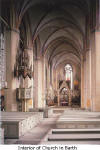 Then, finally, we toured the church whose
steeple was plainly visible to all the POWs. I have been told by
many of the ex-POWs how the church was a source of inspiration and consolation
to many of them. The church dates back to 1250 and was very beautiful. The
organist provided us with a very beautiful private musical program and then we
toured the archives of the church. Then, finally, we toured the church whose
steeple was plainly visible to all the POWs. I have been told by
many of the ex-POWs how the church was a source of inspiration and consolation
to many of them. The church dates back to 1250 and was very beautiful. The
organist provided us with a very beautiful private musical program and then we
toured the archives of the church.
The final night there we were invited by the
mayor of Barth to a dinner banquet at the Barth Town Hall. The champagne
flowed freely and I wondered what the ex-POWs and concentration camp survivors
were thinking, comparing this visit with their earlier visit. I imagine never
in their wildest dreams back in 1945 did they expect to return to Barth in the
year 2000 as guest of the city and to be wined and dined by the mayor of the
city.
Everyone was truly glad they had come. Dr.
Leland Smith said that his family really did not want him to come, but he said
there was just something in Helga's letters to him that made him feel he
needed to return. I believe he and the other ex-POWs all felt a certain sense of closure with this
trip.
I am truly glad that I attended. Initially I
had decided not to go. Then I received a call from Bob Ellsworth, a former Stalag Luft I POW
that I had met last fall at the American Ex-Prisoners of War convention last fall.
He informed me that he could not make the trip, but encouraged me to go
telling me that he had already made two trips back to Barth and was part of
the first group of ex-POWs to return. While I was in Barth, I sent him a postcard
thanking him for encouraging me to make the trip. This was a once in a
lifetime opportunity that Mother and I both are so glad that we had the
opportunity to
participate in.
After leaving Barth we returned to Frankfurt
and our hotel just happened to be located right across the street from the
train station. This is the train station where Dad almost lost his life 55
years ago. We had heard the story from his crew members about seeing the 3
American Airmen hanging from the poles in Frankfurt and the story about the
angry German citizens coming after Dad and his group in the train station
only to be saved by their Luftwaffe guards pushing them into a small donut
shop and calling for more guards to protect them from the civilians. As
we walked around, my mind again wandered to what Dad must have been feeling
and the true terror that he must have felt.
Former POWs of Stalag Luft I
with the town archivist at Stalag Luft I Memorial Site.
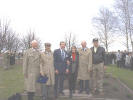
Left to
Right: Virgil Colson, Leland Smith, George Lesko, Helga Radau, Ken Blyth and
Bruce Bockstanz
|
Harbor view of church in Barth. |
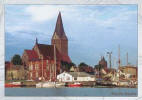 |
|
 |
Barth Street scene |
|
Stalag Luft I Memorial Site Photos
|
Click on thumbnail pictures to view full size and/or
print
Click
on thumbnail pictures to view full size and/or print |
